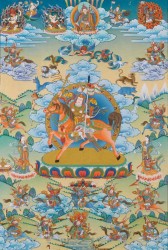King Gesar of Ling

With respect to his mind termas, from The Story of the Secret Key, Padmasambhava says: In that turbulent degenerating time I Lotus-born Guru, will promulgate for the benefit of future generations Various sadhana practices appropriate to the times For the purpose of pacifying, enriching, magnetizing and destroying, Particulary, wrathful rites for averting armies at the border, According to the tradition of Gesar, heroic tamer of negative forces. Gesar of Ling, one of the four main ancestral sovereigns of Shambhala, represents the quintessence of the Tibetan warrior tradition—an enlightened being who took birth as a Buddhist warrior king to defeat the enemies of the dharma. As the Vidyadhara Chögyam Trungpa Rinpoche explains in his Foreward to “The Superhuman Life of Gesar of Ling” by Alexandra David-Neel and Lama Yongden: “In order for us to understand Gesar of Ling, the great warrior king of Tibet, it is necessary first to understand the principle of warriorship itself. This concept has for centuries been the heart of the lineage of Gesar of Ling, whose Tibetan descendents still exist today. Although it has been somewhat influenced by Buddhism, as has virtually all of Tibetan culture, basically the principle of warriorship stands on its own. By warriorship we are not particularly talking about the skills necessary to wage war in the conventional sense. We are not talking about learning how to handle lethal weapons and crank up our aggression and territoriality so that we can burst forth and conquer all our enemies. Warriorship here refers to realizing the power, dignity and wakefulness that is inherent in all of us as human beings. It is awakening our basic human confidence which allows us to cheer up, develop a sense of vision and succeed in what we are doing. Because warriorship is innate in human beings, the way to become a warrior – or the warrior’s path – is to see who and what we are as human beings and cultivate that. Gesar represents the ideal warrior, the principle of all-victorious confidence. As the central force of sanity he conquers all his enemies, the evil forces of the four directions, who turn people’s minds away from the true teachings of Buddhism, the teachings that say it is possible to attain ultimate self-realization. These enemies of the four directions represent quite graphically the different manifestations of cowardly mind which the ideal warrior subjugates through the power of his unconquerable confidence. Gesar’s magical weapons and his magnificent winged charger, Kyan Go Karkar, are also important principles of energy in the warrior’s world. Weapons are the symbol of warriorship itself. The warrior does not carry weapons because he is afraid of being attacked, but rather as an expression of who he is. Weapons actually magnetize the qualities of warriorship and inspire the warrior to be brave and very gentle. Gesar’s winged horse symbolizes the warrior’s confidence. He is the ideal image of something beautiful, romantic, energetic and wild that the warrior can actually capture and ride. Such a horse could be very dangerous and unworkable, but the idea here is that when the warrior has challenged and conquered the enemies of the four directions, then he can ride the great winged horse of confidence and success with dignity and pride.